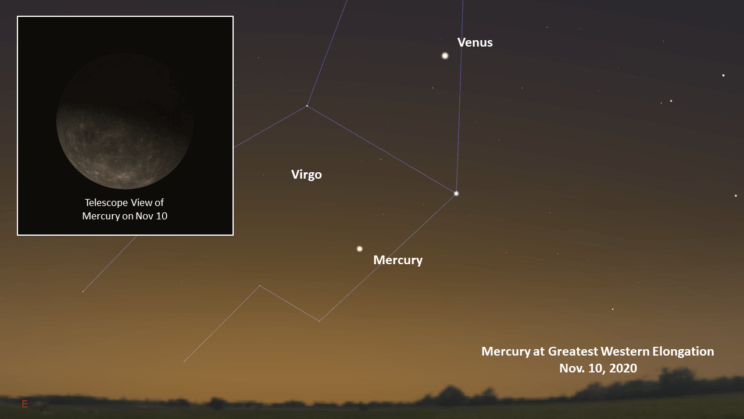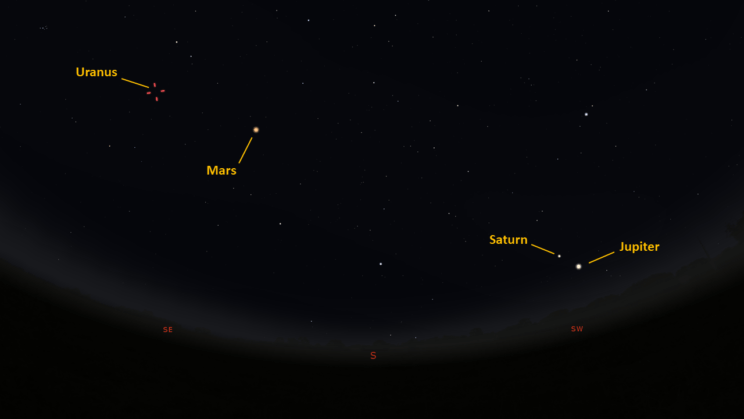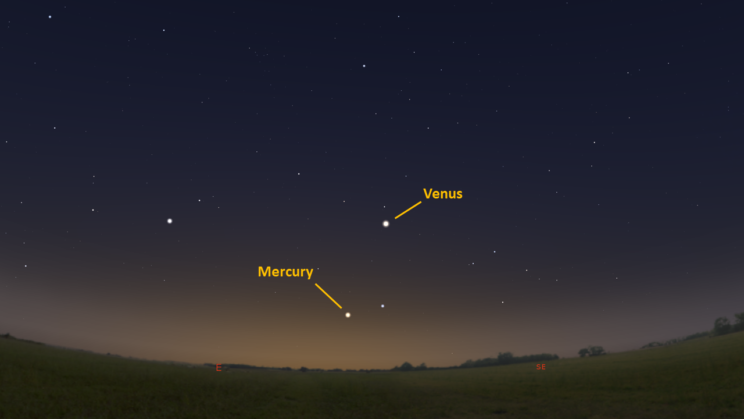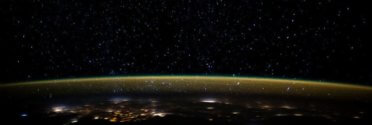This is the Saint Louis Science Center’s NIGHT SKY UPDATE for the week of Friday, November 6, 2020.
Information updated weekly or as needed.
Times given as local St. Louis time (CDT) until October 31. As of November 1, Daylight Saving Time ends, which means times will be posted in Central Standard Time (CST). For definitions of terminology used in the night sky update, click the highlighted text.
Public Telescope Viewings
Star parties at the Saint Louis Science Center have temporarily been canceled due to recommendations from the CDC regarding COVID-19. All public telescope events are canceled until further notice. As conditions change, we will reevaluate and update this article once public observing events resume.
Observing Highlight of the Week

Location of Mercury and Simulated Phase on November 10 at 5:45 am
Credit: Stellarium, EG
The highlight for this week is the planet Mercury. This week Mercury begins another morning apparition. Currently Mercury can be found climbing out of the Sun’s glare just before sunrise. Due to orbital motions, planets will elongate or move away from the Sun from our view on Earth. It is this wandering behavior that lead early humans to understand that planets were different from stars. Eventually Mercury and Venus were described as inferior planets. This means they are closer to the Sun than Earth and they will never be seen overhead at night. You may be familiar with the terms morning and evening stars. These refer to the fact that Mercury and Venus are only seen just before sunrise or just after sunset.
Right now, the visual distance between the Sun and Mercury is elongating towards the west which means we see Mercury in the morning just before sunrise. On November 10, Mercury will reach greatest western elongation after which it will start to head back towards the Sun. To find Mercury, you will want to get outside around 5:45 a.m. and look to the east. Your best bet will be to first find Venus then look about 13° towards the horizon.
Through telescopes, Mercury will reveal that like the Moon, it exhibits phases. Unfortunately no surface details will be seen. What phase we see on Mercury depends on where the planet is in its orbit. Mercury is found to exhibit crescent through gibbous phases. Currently Mercury is a little over 57% phased and will appear gibbous. Spotting Mercury can be dangerous due to how close it appears to the Sun. Anyone planning to view Mercury should make absolute sure that the Sun is below the horizon. Accidentally aiming an unfiltered telescope or binocular at the Sun will cause sever eye damage that can lead to permanent vision loss.
At an average distance of 35.9 million miles from the Sun, Mercury orbits the Sun once every 88 Earth days. This means there are several morning and evening apparitions of Mercury we see each year. Mercury rotates once every 54 Earth days which results in long day and night periods. The dayside of Mercury can be 800°F while the nightside can be -290°F. Mercury has no moons and instead of an atmosphere, Mercury has an exosphere. It is made up of atoms such as O2, Na, H2, He and K that are released due to interactions between Mercury’s surface, the solar wind and micrometeoroid impacts.
Currently, only two spacecraft have visited Mercury: Mariner 10 and Messenger. This will change soon as a new mission called BepiColombo is headed to Mercury. BepiColombo is two orbiter missions from the European (ESA) and Japanese (JAXA) space agencies. BepiColombo will reach Mercury in 2021 first completing 6 flybys of the planet between the years 2021 and 2025. By December of 2025, the BepiColombo mission will start orbiting Mercury. The mission is comprised of the Mercury Planet Orbiter (MPO) from ESA and the Mercury Magnetospheric Orbiter (MMO) from JAXA. If you would like to learn more visit https://solarsystem.nasa.gov/missions/bepicolombo/in-depth/
The Sun and Moon

The Moon as seen from the International Space Station, on July 31, 2011.
Credit: NASA
Sunrise is at 6:34 a.m. on Friday, November 6 and sunset is at 4:55 p.m. providing us with roughly 10.3 hours of daylight. Even after sunset, the light from the Sun will dimly illuminate our sky for about 1 hour and 30 minutes. This period is called twilight, which ends around 6:26 p.m. this week. For those with a sundial, local noon occurs around 11:45 p.m. this week.
| Day | Sunrise | Sunset |
|---|---|---|
| 2020-11-06 | 6:34 a.m. | 4:55 p.m. |
| 2020-11-07 | 6:35 a.m. | 4:54 p.m. |
| 2020-11-08 | 6:36 a.m. | 4:53 p.m. |
| 2020-11-09 | 6:37 a.m. | 4:52 p.m. |
| 2020-11-10 | 6:38 a.m. | 4:51 p.m. |
| 2020-11-11 | 6:39 a.m. | 4:51 p.m. |
| 2020-11-12 | 6:41 a.m. | 4:50 p.m. |
| 2020-11-13 | 6:42 a.m. | 4:49 p.m. |
| 2020-11-14 | 6:43 a.m. | 4:48 p.m. |
Moon
Moonrise for Friday, November 6 occurs at 9:36 p.m. and moonset will occur at 12:46 p.m. on the following day. On Friday, November 6 the Moon will exhibit a waning gibbous phase with 66% of the lunar disk illuminated. Last quarter moon occurs on November 8 at 7:46 a.m.
International Space Station (ISS) Observing

Visible passes of ISS from St. Louis for the week of November 06 occur during morning hours. The best passes this week occur on November 7, 9 and 10. Use the table below for information about these and other visible passes this week.
Catch ISS from St. Louis starting Friday, November 6
| Date | Starts | Max. altitude | Ends | |||||||
|---|---|---|---|---|---|---|---|---|---|---|
| Time | Alt. | Az. | Time | Alt. | Az. | Time | Alt. | Az. | ||
| 07 Nov | -1.1 | 04:27:55 | 15 | NNE | 04:27:55 | 15 | NNE | 04:29:31 | 10 | ENE |
| 07 Nov | -3.6 | 06:01:23 | 10 | NW | 06:04:44 | 73 | NE | 06:08:05 | 10 | ESE |
| 08 Nov | -2.8 | 05:15:12 | 23 | NNW | 05:16:53 | 42 | NE | 05:20:05 | 10 | ESE |
| 09 Nov | -1.7 | 04:29:36 | 25 | NE | 04:29:36 | 25 | NE | 04:31:53 | 10 | E |
| 09 Nov | -2.8 | 06:02:41 | 10 | WNW | 06:05:46 | 34 | SW | 06:08:49 | 10 | SSE |
| 10 Nov | -3.7 | 05:17:03 | 40 | WNW | 05:18:01 | 63 | SW | 05:21:20 | 10 | SE |
| 11 Nov | -2 | 04:31:36 | 32 | ESE | 04:31:36 | 32 | ESE | 04:33:32 | 10 | ESE |
| 12 Nov | -2 | 05:19:12 | 19 | SW | 05:19:12 | 19 | SW | 05:21:23 | 10 | S |
Magnitude (Mag): The Measure of brightness for a celestial object. The lower the value is, the brighter the object will be.
Altitude (Alt): The angle of a celestial object measured upwards from the observer’s horizon.
Azimuth (Az): The direction of a celestial object, measured clockwise from an observer’s location with north being 0°, east being 90°, south being 180° and west being 270°.
For information about ISS flyovers and other visible satellites, visit www.heavens-above.com
Detailed information regarding all unmanned exploration of our universe, missions past, present, and planned, can be found at Jet Propulsion Laboratories:
The Visible Planets

Looking South, at 8:00 pm, November 6, 2020
Credit: Stellarium, EG

Looking East, 5:45 am, November 7, 2020
Credit: Stellarium, EG
This week, five naked eye planets are visible. Jupiter and Saturn rise before sunset. Look for them in the south once it is dark. Mars is found high in the east after sunset. Mercury and Venus can be found in the eastern sky before sunrise.
For those tracking Jupiter and Saturn as they approach their great conjunction later this year, the two gas giants currently appear about 4.43° apart in the sky. From now until December 21, Jupiter will appear closer to Saturn each night.
Mercury
Mercury has started another morning apparition. You can find this elusive planet in the morning sky by 5:45 a.m. It will be a challenging target as civil twilight will start a bit after 6:00 a.m. Mercury reaches greatest western elongation on November 10.
Venus
Venus is well into another morning apparition. After months of seeing Venus in the west after sunset Venus is now visible in the east before sunrise. Venus rises at 3:49 a.m. and will be easily seen by 4:30 a.m. Venus remains a morning object until March 26, 2021 when it reaches superior conjunction. Since Venus has passed greatest western elongation, it will start to exhibit a gibbous phase.
Mars
Mars has passed opposition and now rises before the Sun. Surface features will still be visible through telescopes for some time, but Mars will start to fade as Earth is now moving away from Mars. Observing season for this apparition ends around March 10, 2021 and superior conjunction occurs on October 7, 2021. Currently Mars appears as a -1.9-magnitude object that will be visible in the east about 30 minutes after sunset. Mars will set by 4:11 a.m.
Jupiter
Look for Jupiter in the south about 30 minutes after sunset. Jupiter will set at 9:12 p.m. Those with a telescope can enjoy views of Jupiter’s cloud features and the Great Red Spot when it is pointed towards Earth.
Saturn
Look for the ringed planet in the south about 30 minutes after sunset. Saturn sets at 9:35 p.m. For those with a telescope keep track of the orientation of Saturn’s rings. Since Saturn is tilted on its rotational axis, we cross the plane of Saturn’s ring every 13 to 15 years. We are headed towards another ring plane crossing on March 23, 2025. Over the next five years you will notice Saturn’s rings will gradually incline towards an edge on appearance.
Uranus
Uranus is not a planet we normally include in this section. Even at its dimmest, the giant planet does hover within naked eye visibility. That said, it is so close to the visible limit of the human eye it just is not reality for most of us to see Uranus without binoculars or a telescope. Uranus is just past opposition and as such, it is still easy to spot. You can find Uranus in the constellation Aries the Ram. The current magnitude for Uranus is 5.7. A finder chart for Uranus can be found here.
2020 Great Conjunction
This year the planets Jupiter and Saturn will reach conjunction. A conjunction is when two or more celestial bodies share the same right ascension. For Jupiter and Saturn this astronomical event occurs every 20 years. The conjunction occurs on December 21, 2020. You will find the two planets close together in the southwest just after sunset on this date.
Visit the James S. McDonnell Planetarium for more information on what’s up!
Night Sky Update: November 6-November 14, 2020







